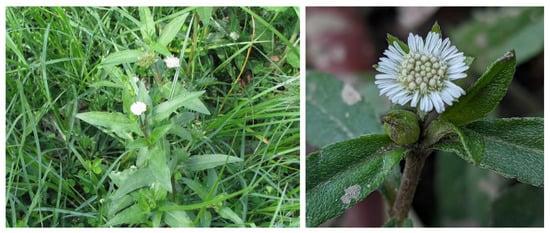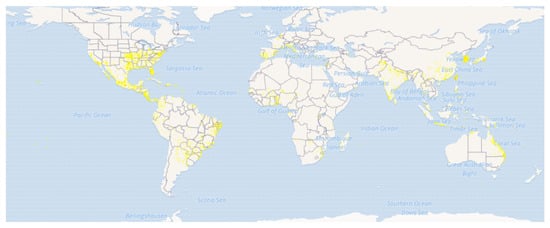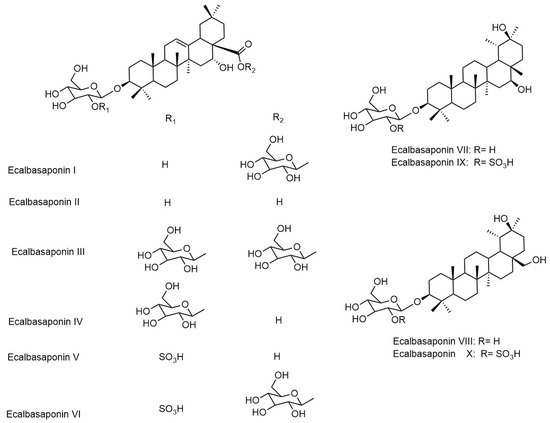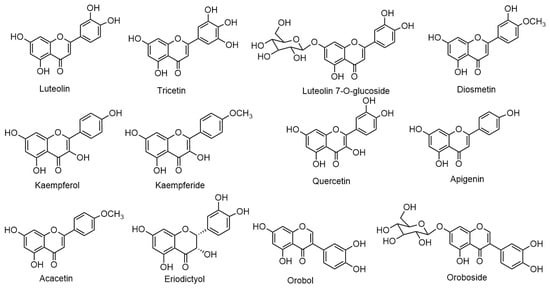You're using an outdated browser. Please upgrade to a modern browser for the best experience.
Please note this is a comparison between Version 1 by Deepak Timalsina and Version 2 by Bruce Ren.
Eclipta prostrata (L.) L. (Syn.: Eclipta alba (L.) Hassak, Family: Asteraceae) is an important medicinal plant in the tropical and subtropical regions. It is widely used in treating various diseases of skin, liver and stomach in India, Nepal, Bangladesh, and other countries.
- Eclipta prostrata
- Eclipta alba
- ecalbasaponin
- hepatoprotective
- wedelolactone
1. Introduction
The use of plants in traditional medicines covers a wide range of therapeutic uses to treat the infection as well as many chronic diseases [1][2][3][4][1,2,3,4]. Many people still rely on the traditional medicine and healthcare because of their wider cultural acceptance and affordability [5]. The plant based bioactive compounds have been an important source of modern drugs discovery and development [6]. Hence, the medicinal value of various plants should be explored with their pharmacological significance and potential application in different products.
Eclipta prostrata (L.) L. (Syn.: Eclipta alba (L.) Hassak, Family: Asteraceae) is commonly known as False daisy or Ink plant in English and locally known as Bhringraj, Bhumiraj, Aali jhar, and Nash jhar in Nepali language (Figure 1) [7][8][7,8]. E. prostrata is a medium-sized, branched, annual herb-bearing white flower natively found in the tropical and subtropical regions of the world [9][10][9,10]. It grows mostly in moist sites such as swamp edges, river or lake banks and edge of rice-fields and easily propagated and spread throughout China, India, Nepal, Brazil and other parts of the world [8][11][12][13][8,11,12,13]. It is widely distributed in tropical and sub-tropical regions of Asia, Africa, and South America (Figure 2) [14][15][14,15]. Traditionally, it is used to treat different skin problems such as wounds, hair loss prevention, and dermatitis. The leaves are used to treat snakebite in India, China, and Brazil. The mixture of leaf juice and honey is used to cure catarrh in infants [16][17][16,17]. The juice of E. prostrata is taken orally or applied locally to promote hair growth [18].

Figure 1. Photographs of Eclipta prostrata (Photos by Basu Dev Neupane, used with permission).

Figure 2. Distribution map of Eclipta prostrata. (Source: GBIF, https://www.gbif.org/species/5384950 (accessed on 1 November 2021) [15]).
Various research articles have been published regarding the chemical constituents and biological activities of different plant parts of E. prostrata. Critical analysis of these published scientific studies would provide the detailed understanding about the potential use of E. prostrata as medicine, cosmetic, and other formulations along with highlighting the gaps in research.
2. Ethnomedicinal Uses
This plant is widely used in different regions of India for the treatment of skin problems, hepatic problems such as jaundice, gastrointestinal problems, respiratory problems such as asthma, and other symptoms such as fever, hair loss and whitening of hair, cuts, and wounds, spleen enlargement, etc. [19][20][19,20]. The leaf juice is used with honey to cure catarrh in infants, shoot juice and mustard oil is taken together for diarrhea and dysentery, and the whole plant is used for the treatment of symptoms related to hepatitis, itching, hemoptysis, bleeding, hematuria, diarrhea, and diphtheria [16]. The leaves and shoots are used in preventing infection in wounds and its treatment in Nepal [7][8][11][21][7,8,11,21]. Some ethnic groups in South American countries use it to treat snakebites [22]. In Ayurveda, it is used for its revitalizing and anti-aging properties [23]. Many ethnic groups of Bangladesh use it for the treatment of jaundice [24][25][24,25]. The plant juice has been used to control, kill, and inhibit the growth of diseases carrying vectors such as mosquito [26][27][26,27]. Additionally, it is also used to treat different types of symptoms such as acidity, alopecia [28], gingivitis, fever, body pain, asthma, bronchitis, burns, constipation, wounds, wrinkles, edema, pimples, and other skin diseases [29][30][31][32][29,30,31,32].
3. Bioactive Chemical Constituents
Eclipta prostrata contains a wide range of active phytoconstituents, which includes coumestan derivatives, triterpene saponins, steroidal saponins, triterpenes, steroids, steroidal alkaloids, flavonoids, phenolic acids, thiophene derivatives and many other compounds. Most of the chemical analysis are reported for whole plant or aerial parts. The detailed list of these compounds is given in Table 1 and Table 2. The structures of main coumestan derivatives, triterpene saponins and flavonoids are represented in Figure 3, Figure 4 and Figure 5, respectively.




Figure 3. Structures of major coumestan derivatives.

Figure 4. Structures of main triterpene saponins.

Figure 5. Structures of main flavonoids.
Table 1. Coumestan, steroid and triterpene derivatives and related compounds from various parts of E. prostrata.
| Chemical Compounds (Class/Constituents) | Plant Parts | References | ||||||||||||
|---|---|---|---|---|---|---|---|---|---|---|---|---|---|---|
| Coumestan derivatives | ||||||||||||||
| Wedelolactone | Leaves | [21][33][34][35][36] | [21,33,34,35,36] | |||||||||||
| Demethylwedelolactone | Leaves | [35][36] | [35,36] | |||||||||||
| Isodemethylwedelolactone | Whole plant | [36] | ||||||||||||
| Strychnolactone | Whole plant | [36] | ||||||||||||
| Demethylwedelolactone glucoside | Aerial Parts | [37] | ||||||||||||
| Steroidal and triterpene saponins, steroidal alkaloids, steroids and triterpenoids | ||||||||||||||
| Eclalbasaponins I | Whole plant | [34][38][39] | [34,38,39] | |||||||||||
| Eclalbasaponins II | Whole plant | [34][38][39] | [34,38,39] | |||||||||||
| Eclalbasaponins III | Whole plant | [34][38][39] | [34,38,39] | |||||||||||
| Eclalbasaponins IV | Whole plant | [38][39] | [38,39] | |||||||||||
| Eclalbasaponins V | Whole plant | [34][38][39] | [34,38,39] | |||||||||||
| Eclalbasaponins VI | Whole plant | [38][39] | [38,39] | |||||||||||
| Eclalbasaponins VII | Whole plant | [38] | ||||||||||||
| Eclalbasaponins VIII | Whole plant | [38] | ||||||||||||
| Eclalbasaponins IX | Whole plant | [38] | ||||||||||||
| Eclalbasaponins X | Whole plant | [38] | ||||||||||||
| Eclalbasaponin XI | Whole plant | [38] | ||||||||||||
| Eclalbasaponin XII | Whole plant | [38] | ||||||||||||
| Eclalbasaponin XIII | Whole plant | [38] | ||||||||||||
| Eclalbasaponin A | Whole plant | [40] | ||||||||||||
| Eclalbasaponin B | Whole plant | [40] | ||||||||||||
| Eclalbasaponin C | Whole plant | [40] | ||||||||||||
| Eclalbasaponin D | Whole plant | [40] | ||||||||||||
| Echinocystic acid | Whole plant | [40] | ||||||||||||
| Echinocystic acid-3- | O | -(6- | O | -acetyl)- | β | -D-glucopyranoside | Aerial parts | [41] | ||||||
| Eclalbatin | Aerial Parts | [42][43] | [42,43] | |||||||||||
| 3 | β | ,25-Dihydroxy-23 | E | -lemmaphyll-8,23-diene | Whole plant | [44] | ||||||||
| 16 | α | -Hydroxy-olean-12-en-3-on-28,21 | β | -olide | Whole plant | [44] | ||||||||
| 3 | β | -Hydroxy-17-epi-28-norolean-12-en-16-one 3- | O | - | β | -D-glucopyranoside | Whole plant | [44] | ||||||
| 3 | β | - | O | -(6- | O | -Crotonyl- | β | -D-glucopyranosyl)-16α-hydroxy-olean-12-en-28-oic acid 28- | O | - | β | -D-glucopyranosyl ester | Whole plant | [44] |
| 3- | O | -(2- | O | -Acetyl- | β | -D-glucopyranosyl) oleanolic acid-28- | O | -( | β | -D-glucopyranosyl) ester | Aerial parts | [45] | ||
| 3- | O | -(6- | O | -Acetyl- | β | -D-glucopyranosyl) oleanolic acid-28- | O | -( | β | -D-glucopyranosyl) ester | Aerial parts | [45] | ||
| 3- | O | -( | β | -D-Glucopyranosyl) oleanolic acid-28- | O | -(6- | O | -acetyl- | β | -D-glucopyranosyl) ester | Aerial parts | [45] | ||
| 3 | β | ,16 | β | ,29-Trihydroxy oleanane-12-ene-3- | O | - | β | -D-glucopyranoside | Aerial parts | [46] | ||||
| 3,28-di-O- | β | -D-Glucopyranosyl-3 | β | ,16 | β | -dihydroxy oleanane-12-ene-28-oleanlic acid | Aerial parts | [46] | ||||||
| 3- | O | - | β | -D-Glucopyranosyl-(1-2)- | β | -D-glucopyranosyl oleanlic-18- ene acid-28- | O | - | β | -D-glucopyranoside | Aerial parts | [46] | ||
| ( | 20S | )( | 25S | )-22,26-Imino-cholesta-5,22( | N | )-dien-3 | β | -ol (Verazine) | Leaves | [47] | ||||
| 20- | epi | -3-Dehydroxy-3-oxo-5,6-dihydro-4,5-dehydroverazine | Leaves | [32][47] | [32,47] | |||||||||
| ( | 20R | )-20-Pyridyl-cholesta-5-ene-3 | β | ,23-diol (Ecliptalbine) | Leaves | [47] | ||||||||
| ( | 20R | )-25 | β | -Hydroxyverazine | Leaves | [47] | ||||||||
| 20- | epi | -4 | β | -Hydroxyverazine | Leaves | [47] | ||||||||
| 20- | epi | -25 | β | -Hydroxyverazin | Leaves | [47] | ||||||||
| 4 | β | -Hydroxyverazine | Leaves | [47] | ||||||||||
| 25 | β | -Hydroxyverazine | Leaves | [47] | ||||||||||
| Lanost-5,24-dien-3 | β | -ol-18, 21-olide -3 | β | - yl tetradecanoate | Whole plant | [48] | ||||||||
| α-Amyrin | Whole plant | [43] | ||||||||||||
| Ursolic acid | Whole plant | [43] | ||||||||||||
| Oleanolic acid | Whole plant | [43] | ||||||||||||
| 3-Oxo-16 | α | -hydroxy-olean-12-en-28-oic acid | Aerial parts | [49] | ||||||||||
| Machaeroceric acid | Aerial parts | [34] | ||||||||||||
| Silphioside C | Whole plant | [50] | ||||||||||||
| β | -Sitosterol | Whole plant | [36] | |||||||||||
| Stigmasterol | Leaves/Stems | [40] | ||||||||||||
| Stigmasterol-3- | O | -glucoside | Aerial parts/leaves/Stems | [19][34][40] | [19,34,40] | |||||||||
| 3- | O | -(6′- | O | -Palmitoyl- | β | -D-glucopyranosyl) stigmasterol | Whole plant | [50] | ||||||
| Daucosterol | Leaves/Stems | [40] | ||||||||||||
Table 2. Flavonoids, phenolic acids, substituted thiophines, and other compounds present in the E. prostrata.
| Flavonoids | ||||||||||||||||||||
| Luteolin | Aerial parts | [34][41][51] | [34,41,51] | |||||||||||||||||
| Tricetin | Aerial parts | [34] | ||||||||||||||||||
| Luteolin-7- | O | - | β | -D-glucoside | Aerial parts | [34][41][51] | [34,41,51] | |||||||||||||
| Diosmetin | Aerial parts | [52] | ||||||||||||||||||
| Skullcapflavone Ⅱ | Whole plant | [51] | ||||||||||||||||||
| Kaempferol | Whole plant | [51] | ||||||||||||||||||
| Kaempferol-7- | O | - | α | -D-rhamnoside | Aerial parts | [34] | ||||||||||||||
| Kaempferide | Whole plant | [51] | ||||||||||||||||||
| Quercetin | Aerial parts | [51][53] | [51,53] | |||||||||||||||||
| Quercetin-3- | O | - | β | -D-glucoside | Aerial parts | [34] | ||||||||||||||
| Apigenin | Aerial parts | [34][41][51] | [34,41,51] | |||||||||||||||||
| Acacetin | Whole plant | [51] | ||||||||||||||||||
| Acacetin-7- | O | -rutinoside | Whole plant | [51] | ||||||||||||||||
| Eriodictyol | Whole plant | [50] | ||||||||||||||||||
| Pyracanthoside | Whole plant | [50] | ||||||||||||||||||
| Hesperetin-7- | O | - | β | -D-glucoside | Aerial parts | [34] | ||||||||||||||
| 3′-Hydroxybiochanin A | Aerial Parts | [37][49] | [37,49] | |||||||||||||||||
| Orobol (isoluteolin) | Whole plant | [31][34] | [31,34] | |||||||||||||||||
| 7- | O | -Methylorobol-4′ | -O | - | β | -D-glucopyranoside | Aerial Parts | [34][49][50] | [34,49,50] | |||||||||||
| 7-Dihydroxyl-3′, 6′-dimethoxylisoflavone-7- | O | -glucoside | Whole plant | [51] | ||||||||||||||||
| 3′- | O | -Methylorobol | Aerial parts | [50][52] | [50,52] | |||||||||||||||
| Pratensein | Aerial parts | [37][49][50] | [37,49,50] | |||||||||||||||||
| Pratensein-7- | O | - | β | -D-glucopyranoside | Aerial parts | [41][50] | [41,50] | |||||||||||||
| Oroboside (Orobol-7-O-β-D-glucoside) | Whole plant | [34][37][50][51] | [34,37,50,51] | |||||||||||||||||
| Phenolic acids | ||||||||||||||||||||
| Protocatechuic acid | Leaves/Steam/Whole plant | [34][36][40][43] | [34,36,40,43] | |||||||||||||||||
| 4-Hydroxybenzoic acid | Leaves/Steam | [34][40][43] | [34,40,43] | |||||||||||||||||
| Vanillic acid | Aerial parts | [34] | ||||||||||||||||||
| Syringic acid | Aerial parts | [34] | ||||||||||||||||||
| Chlorogenic acid | Aerial parts | [34] | ||||||||||||||||||
| Syringic acid | Aerial parts | [34] | ||||||||||||||||||
| Tachinoside | Whole plant | [50] | ||||||||||||||||||
| Coniferylaldehyde | Whole plant | [50] | ||||||||||||||||||
| Leonuriside A | Whole plant | [50] | ||||||||||||||||||
| Caffeic acid | Whole plant | [50] | ||||||||||||||||||
| Ferulic acid ethyl ester | Whole plant | [50] | ||||||||||||||||||
| Caffeic acid ethyl ester | Whole plant | [50] | ||||||||||||||||||
| Lignin | ||||||||||||||||||||
| Ecliptalignin A | ||||||||||||||||||||
| Coumarins | ||||||||||||||||||||
| Psoralen | Whole plant | [51] | ||||||||||||||||||
| Isopsoralen | Whole plant | [51] | ||||||||||||||||||
| Polyacetylinic compounds | ||||||||||||||||||||
| (5 | E | )-Hendeca-1,5- dien-7,9-diyne-diol-4-O- | β | -D-glucopyranoside | Stem | [54] | ||||||||||||||
| (5 | E | )-Trideca-1,5-dien-7,9,11-triyne-3,4-diol-4- | O | - | β | -D-glucopyranoside | Stem | [46][54] | [46,54] | |||||||||||
| 3- | O | - | β | -D-Glucopyranosyl1-hydroxy-4 | E | ,6 | E | -tetradecene,8,10,12-triyne | Stem | [46][54] | [46,54] | |||||||||
| 2- | O | - | β | -D-Glucosyltrideca-3 | E | ,11 | E | -dien5,7,9-triyne-1,2,13-triol | Stem | [54] | ||||||||||
| 2- | O | - | β | -D-Glucosyltrideca-3 | E | ,11 | E | -dien-5,7,9-triyne-1,2-diol | Stem | [54] | ||||||||||
| 2- | O | - | β | -D-Glucosyltrideca-3 | E | ,11 | Z | -dien-5,7,9-triyne3–1,2-diol | Stem | [54] | ||||||||||
| Substituted thiophenes | ||||||||||||||||||||
| 5-Hydroxymethyl-(2,2′:5′,2″)-terthienyl tiglate | Whole plant | [55] | ||||||||||||||||||
| 5-Hydroxymethyl-(2,2′:5′,2″)-terthienyl agelate | Whole plant | [55] | ||||||||||||||||||
| 5-Hydroxymethyl-(2,2′:5′,2″)-terthienyl acetate | Whole plant | [55] | ||||||||||||||||||
| 5-Formyl-(2, 2:5, 2″)-terthiophene (Ecliptal) | Whole plant | [56] | ||||||||||||||||||
| 5-Hydroxymethyl-(2, 2: 5, 2″)-terthiophene (α-terthienylmethanol) | Whole plant | [56] | ||||||||||||||||||
| 5-Methoxy-(2, 2:5, 2″)-terthiophene | Whole plant | [56] | ||||||||||||||||||
| 3′-Methoxy-2,2′:5′,2″-terthiophene | Aerial parts | [41] | ||||||||||||||||||
| 5-(3″,4″-Dihydroxy-1″-butynyl)-2,2′-bithiophene | Aerial parts | [41] | ||||||||||||||||||
| α-Terthienyl | Aerial parts | [41] | ||||||||||||||||||
| α-Formylterthienyl | Whole plant | [54] | ||||||||||||||||||
| α-Terthienyl methanol | Whole plant | [41][54][56] | [41,54,56] | |||||||||||||||||
| 3′-Methoxy-2,2′:5′,2″-terthiophene | Aerial parts | [41] | ||||||||||||||||||
| 4-(2,2′-Bithiophen-5-yl)but-3-yne-1,2-diol | Aerial parts | [57] | ||||||||||||||||||
| Arctinol B | Aerial parts | [57] | ||||||||||||||||||
| 2-(Penta-1,3-diynyl)-5-(3,4-dihydroxy-but-1-ynyl)-thiophene | Aerial parts | [57] | ||||||||||||||||||
| 6-Methoxy-arctinol-b | Aerial parts | [57] | ||||||||||||||||||
| 5-[l-(4-Hydroxybut-l-ynyl)]-2,20 -bithiophene-50 -carbaldehyde | Aerial parts | [57] | ||||||||||||||||||
| 5-Hydroxymethyl- (2,2′:5′,2′’-terthienyl) | Aerial parts | [57] | ||||||||||||||||||
| 5′-Hydroxymethyl-5-(3-butene-1-ynyl)-2,2′ -bithiophene | Aerial parts | [46][57] | [46,57] | |||||||||||||||||
| 3′-Hydroxy-2,2′:5′,2′’ terthiophene-3′-O- | β | -D-glucopyranoside | Aerial parts | [57] | ||||||||||||||||
| Ecliprostin A | Aerial parts | [58] | ||||||||||||||||||
| Ecliprostin B | Aerial parts | [58] | ||||||||||||||||||
| Ecliprostin C | Aerial parts | [58] | ||||||||||||||||||
| Alkaloids | ||||||||||||||||||||
| Crinumaquine | Whole plant | [51] | ||||||||||||||||||
| 2,3,9,12-Tetramethoxyprotoberberine | Whole plant | [51] | ||||||||||||||||||
| Lignans | ||||||||||||||||||||
| Pinoresinol-4-O-β-D-glucopyranoside | Whole plant | [50] | ||||||||||||||||||
| 4,4′-Dimethoxy-3′-hydroxy-7,9′:7′,9-diepoxylignan-3-O-β-D-glucopyranoside | Whole plant | [50] | ||||||||||||||||||
| Syringaresinol-4′-O-β-D-glucopyroside | Whole plant | [50] | ||||||||||||||||||
| Lanicepside A | Whole plant | [50] | ||||||||||||||||||
| Longifloroside | Whole plant | [50] | ||||||||||||||||||
| Other compounds | ||||||||||||||||||||
| 1- | O | -Octadecanoyl-2- | O | -(9 | Z | ,12 | Z | -octadecadienoyl)-3- | O | -[ | α | -D-galactopyranosyl- (1′′ | → | 6′)- | O | - | β | -D-galactopyranosyl]glycerol | Whole plant | [50] |
| ( | 2S | )-3- | O | -α-D-Galactopyranosyl-(1′′ | → | 6′)- | β | -D-galactopyranosyl-1,2-di- | O | -[(9Z,12Z,15Z)-octadeca-9,12,15-trienoyl]-sn-glycerol | Whole plant | [50] | ||||||||
| 1- | O | -(9 | Z | ,12 | Z | ,15 | Z | -Octadecatrienoyl)-2- | O | -hexadecanoyl-3- | O | -[α-D-galactopyranosyl-(1′′ | → | 6′)- | O | - | β | -D-galactopyranosyl]glycerol | Whole plant | [50] |
| 1- | O | -( | β | -D-glucopyranosyl)- ( | 2S,3S,4R,8Z | )-2 | N | -[(2′ | R | )-2′-hydroxytetracosanoyl]-8-( | Z | )-octadecene-1,3,4-triol | Whole plant | [50] | ||||||
| ( | 2S,3S,4R,10E | )-2-[( | 2′R | )-2′- Hydroxytetracosanoylamino]-10-octadecene-1,3,4-triol | Whole plant | [50] | ||||||||||||||
| ( | 3S,5R,6S,7E,9R | )-3-Hydroxy-5,6-epoxy- | β | -ionyl-3- | O | - | β | -D-glucopyranoside | Whole plant | [50] | ||||||||||
| Euodionoside A | Whole plant | [50] | ||||||||||||||||||
| Junipeionoloside | Whole plant | [50] | ||||||||||||||||||
| Calaliukiuenoside | Whole plant | [50] | ||||||||||||||||||
| rel | -( | 1S,2S,3S,4R,6R | )-1,6-Epoxy-menthane-2,3-diol-3- | O | - | β | -D-glucopyranoside | Aerial parts | [46] | |||||||||||
| rel | -( | 1S,2S,3S,4R,6R | )-3- | O | -(6- | O | -caffeoyl- | β | -D-glucopyranosyl)-1,6-epoxy menthane-2,3-diol | Aerial parts | [46] | |||||||||
| Siliphioside E | Aerial parts | [46] | ||||||||||||||||||
| ( | 2E,6E | )- 2,6,10-trimethyl-2,6,11-dodecatriene-1,10-diol-1- | O | - | β | -D-glucopyranoside | Aerial parts | [46] | ||||||||||||
| ( | 2S | )-1- | O | -Stearoyl-3-O- | β | -D-galactopyranosyl-sn-glycerol | Aerial parts | [34] | ||||||||||||
| ( | 2S | )-3- | O- | ( | 9Z,12Z | -Octadecadienoyl) glyceryl- | O | - | β | -D-galactopyranoside | Aerial parts | [34] | ||||||||
| Bidensmenthoside A | Whole plant | [50] | ||||||||||||||||||
| Bidensmenthoside B | Whole plant | [50] | ||||||||||||||||||
| 11 | β | ,17-Dihydroxy-beyer-15-ene | Whole plant | [44] | ||||||||||||||||
| 4 | β | - Hydroxy-guai-10(14),11(13)-dien-12-oic acid | Whole plant | [44] | ||||||||||||||||
